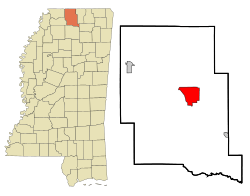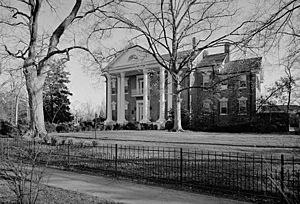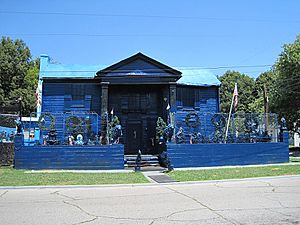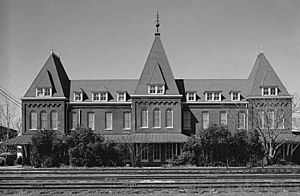Holly Springs, Mississippi facts for kids
Quick facts for kids
Holly Springs, Mississippi
|
|||
|---|---|---|---|

Business district of Holly Springs
|
|||
|
|||

Location in Marshall County and the state of Mississippi
|
|||
| Country | United States | ||
| State | Mississippi | ||
| County | Marshall | ||
| Area | |||
| • Total | 12.80 sq mi (33.14 km2) | ||
| • Land | 12.78 sq mi (33.09 km2) | ||
| • Water | 0.02 sq mi (0.05 km2) | ||
| Elevation | 587 ft (179 m) | ||
| Population
(2020)
|
|||
| • Total | 6,968 | ||
| • Density | 545.35/sq mi (210.56/km2) | ||
| Time zone | UTC-6 (Central (CST)) | ||
| • Summer (DST) | UTC-5 (CDT) | ||
| ZIP codes |
38634, 38635, 38649
|
||
| Area code(s) | 662 | ||
| FIPS code | 28-33100 | ||
| GNIS feature ID | 2404717 | ||


Holly Springs is a city in Marshall County, Mississippi, United States. It is the main city and county seat of Marshall County. The city is located close to the border with Tennessee to the north.
In 2020, about 6,968 people lived in Holly Springs. This was a bit less than the 7,699 people counted in 2010. In the 1800s, this area was known for its large cotton farms, called plantations. After the Civil War, many freedmen (formerly enslaved people) continued to work on farms. They often worked as sharecroppers or tenant farmers.
As the county seat, Holly Springs is an important place for trade and court meetings. The city has many buildings and areas listed on the National Register of Historic Places. These include the Southwest Holly Springs Historic District and the Holly Springs Courthouse Square Historic District. Hillcrest Cemetery is also here. It holds the graves of five Confederate generals and is sometimes called "Little Arlington of the South."
Contents
History of Holly Springs
Early Settlement and Growth
European Americans started Holly Springs in 1836. Before this, the Chickasaw people had lived on this land for hundreds of years. Most of their land was given up in the Treaty of Pontotoc Creek in 1832. Many of the first American settlers came from Virginia, Georgia, and the Carolinas.
By 1836, about 4,000 European-American people lived in the city. A year later, there were 40 lawyers. By 1838, there were six doctors. In 1837, the town already had many shops. It had "twenty dry goods stores, two drugstores, three banks, several hotels, and over ten saloons." Hillcrest Cemetery was built on land given to the city in 1837.
Newcomers also started the Chalmers Institute. This school later became the University of Holly Springs. It is Mississippi's oldest university.
Cotton and the Civil War
The area grew a lot of cotton on large plantations. These farms relied on the hard work of enslaved African Americans. Many enslaved people were brought here from other parts of the South. This often broke up their families. Holly Springs became a busy trading center for these cotton plantations.
In 1837, Holly Springs became the main city for the new Marshall County. The county was named after John Marshall, a Supreme Court justice. The town had many businesses to support the plantations. For a long time, it also had a community of Jewish merchants.
The cotton business faced problems in 1840 but soon got better. By 1855, Holly Springs was connected to Grand Junction, Tennessee, by the Mississippi Central Railway. Later, another railroad, the Kansas City, Memphis and Birmingham Railroad, was built through Holly Springs.
During the Civil War, Union General Ulysses S. Grant used Holly Springs as a supply base. He was trying to capture Vicksburg. In December 1862, Confederate General Earl Van Dorn led a successful attack called the Holly Springs Raid. He destroyed most of the Union supplies. The Holly Springs Female Institute, a school that had been open since 1836, was also burned down and closed forever. Grant eventually won the siege of Vicksburg.
After the War
In 1878, Holly Springs had a serious yellow fever outbreak. This was part of a larger sickness in the region. About 1,400 people got sick, and 300 died. The Marshall County courthouse was used as a hospital during this time.
After the war, many freedmen stayed in the area. They often worked as sharecroppers on the old plantations. Life was sometimes difficult and tense after the war.
In the early 1900s, farming became more modern. This meant fewer jobs on farms. From 1900 to 1910, a quarter of the city's population moved away. Many African Americans moved North in the Great Migration. They wanted to escape unfair treatment in the South and find factory jobs.
Later, tiny insects called boll weevils destroyed cotton crops in the 1920s and 1930s. This caused big economic problems, along with the Great Depression. Some small factories started in the area. But after World War II, most big industries moved to larger cities like Memphis, Tennessee, and Birmingham, Alabama.
Geography and Climate
Location and Area
Holly Springs is located a little east of the center of Marshall County. Interstate 22 runs along the southwest edge of the city. You can get to it from exits 26 and 30. I-22 goes northwest to Memphis, Tennessee, which is about 46 miles away. It goes southeast about 60 miles to Tupelo.
State highways 4 and 7 go through the middle of Holly Springs. Highway 4 goes east about 18 miles to Ashland. It goes southwest about 34 miles to Senatobia. Highway 7 goes south about 30 miles to Oxford. It goes northeast toward Bolivar, Tennessee, about 45 miles away.
The U.S. Census Bureau says Holly Springs covers about 12.8 square miles. Only a very small part, about 0.02 square miles, is water. The city is on high ground. Water from the city flows north and west into parts of the Coldwater River. It also flows southeast into Big Spring Creek, which is part of the Little Tallahatchie River.
Weather in Holly Springs
Holly Springs has hot, humid summers. Its winters are usually mild to cool. This type of weather is called a humid subtropical climate.
On December 23, 2015, a very strong EF4 tornado hit the town. This happened around 6:00 pm. It caused a lot of damage. Sadly, one boy died. Nearly 200 buildings in Marshall County were damaged by the tornado. Some were completely destroyed.
| Climate data for Holly Springs, Mississippi (1991–2020, extremes 1962–present) | |||||||||||||
|---|---|---|---|---|---|---|---|---|---|---|---|---|---|
| Month | Jan | Feb | Mar | Apr | May | Jun | Jul | Aug | Sep | Oct | Nov | Dec | Year |
| Record high °F (°C) | 78 (26) |
81 (27) |
86 (30) |
92 (33) |
95 (35) |
103 (39) |
106 (41) |
105 (41) |
101 (38) |
93 (34) |
88 (31) |
78 (26) |
106 (41) |
| Mean daily maximum °F (°C) | 49.9 (9.9) |
54.8 (12.7) |
63.7 (17.6) |
72.9 (22.7) |
80.3 (26.8) |
87.3 (30.7) |
90.5 (32.5) |
90.1 (32.3) |
85.0 (29.4) |
74.6 (23.7) |
62.8 (17.1) |
53.0 (11.7) |
72.1 (22.3) |
| Daily mean °F (°C) | 39.5 (4.2) |
43.4 (6.3) |
51.8 (11.0) |
60.2 (15.7) |
68.6 (20.3) |
76.1 (24.5) |
79.4 (26.3) |
78.3 (25.7) |
71.9 (22.2) |
60.8 (16.0) |
50.5 (10.3) |
42.6 (5.9) |
60.3 (15.7) |
| Mean daily minimum °F (°C) | 29.2 (−1.6) |
31.9 (−0.1) |
39.8 (4.3) |
47.4 (8.6) |
56.9 (13.8) |
65.0 (18.3) |
68.4 (20.2) |
66.5 (19.2) |
58.8 (14.9) |
47.1 (8.4) |
38.2 (3.4) |
32.1 (0.1) |
48.4 (9.1) |
| Record low °F (°C) | −5 (−21) |
0 (−18) |
6 (−14) |
23 (−5) |
32 (0) |
40 (4) |
50 (10) |
43 (6) |
33 (1) |
20 (−7) |
11 (−12) |
−12 (−24) |
−12 (−24) |
| Average precipitation inches (mm) | 4.69 (119) |
4.93 (125) |
6.09 (155) |
6.09 (155) |
5.43 (138) |
4.71 (120) |
4.58 (116) |
3.35 (85) |
3.94 (100) |
4.24 (108) |
4.46 (113) |
5.66 (144) |
58.17 (1,478) |
| Average snowfall inches (cm) | 0.9 (2.3) |
0.9 (2.3) |
0.3 (0.76) |
0.0 (0.0) |
0.0 (0.0) |
0.0 (0.0) |
0.0 (0.0) |
0.0 (0.0) |
0.0 (0.0) |
0.0 (0.0) |
0.0 (0.0) |
0.2 (0.51) |
2.3 (5.8) |
| Average precipitation days (≥ 0.01 in) | 11.4 | 9.4 | 10.7 | 10.0 | 10.1 | 8.7 | 9.5 | 7.6 | 7.4 | 7.7 | 9.2 | 11.2 | 112.9 |
| Average snowy days (≥ 0.1 in) | 0.4 | 0.4 | 0.2 | 0.0 | 0.0 | 0.0 | 0.0 | 0.0 | 0.0 | 0.0 | 0.0 | 0.1 | 1.1 |
| Source: NOAA | |||||||||||||
Population of Holly Springs
| Historical population | |||
|---|---|---|---|
| Census | Pop. | %± | |
| 1860 | 2,987 | — | |
| 1870 | 2,406 | −19.5% | |
| 1880 | 2,370 | −1.5% | |
| 1890 | 2,246 | −5.2% | |
| 1900 | 2,815 | 25.3% | |
| 1910 | 2,192 | −22.1% | |
| 1920 | 2,113 | −3.6% | |
| 1930 | 2,271 | 7.5% | |
| 1940 | 2,750 | 21.1% | |
| 1950 | 3,276 | 19.1% | |
| 1960 | 5,621 | 71.6% | |
| 1970 | 5,728 | 1.9% | |
| 1980 | 7,285 | 27.2% | |
| 1990 | 7,261 | −0.3% | |
| 2000 | 7,957 | 9.6% | |
| 2010 | 7,699 | −3.2% | |
| 2020 | 6,968 | −9.5% | |
| U.S. Decennial Census | |||
What the 2020 Census Shows
| Race | Num. | Perc. |
|---|---|---|
| White | 1,193 | 17.12% |
| Black or African American | 5,521 | 79.23% |
| Native American | 4 | 0.06% |
| Asian | 7 | 0.1% |
| Pacific Islander | 7 | 0.1% |
| Other/Mixed | 162 | 2.32% |
| Hispanic or Latino | 74 | 1.06% |
In 2020, there were 6,968 people living in Holly Springs. There were 2,369 households and 1,259 families.
What the 2010 Census Showed
In 2010, there were 7,699 people in the city. Most of the people were African American (79.2%). About 19.3% were White. Other groups made up smaller parts of the population. About 1.2% of people were Hispanic or Latino.
Education in Holly Springs
The schools in the city are part of the Holly Springs School District. Marshall Academy is a private school. It teaches students from pre-kindergarten through 12th grade.
Rust College was started in 1866. It was founded by the Freedman's Aid Society of the Methodist Episcopal Church. Its purpose was to educate freedmen (formerly enslaved people). It is a historically black college.
Two other colleges, the Mississippi Industrial College and the Holly Springs Female Institute, used to be in Holly Springs but are now closed.
Notable People from Holly Springs
- Seth Adams (born 1985), football player for the University of Mississippi
- Robert Belfour (1940-2015), a blues musician
- Spires Boling (1812–1880), an architect and builder
- R. L. Burnside (1926–2005), a blues musician
- Kate Freeman Clark (1875–1957), a painter
- Edward Hull "Boss" Crump (1874–1954), a powerful politician in Memphis; born in Holly Springs
- Cassi Davis (born 1964), an actress
- Clifton DeBerry (1924–2006), the first African American nominated for President of the United States by a political party; born in Holly Springs
- Wall Doxey (1892–1962), a Mississippi politician who served as a congressman and U.S. senator
- Charlie Feathers, (1932-1998), a rockabilly musician
- Winfield S. Featherston (1820–1891), a member of the United States House of Representatives and a Confederate general
- William Baskerville Hamilton (1908-1972), a historian who taught in Holly Springs
- Syl Johnson (1936-2022), a blues and soul singer
- Verina Morton Jones (1865–1943), an African-American doctor and the first woman to practice medicine in Mississippi
- Junior Kimbrough (1930–1998), a blues musician
- Jeremy LeSueur (born 1980), football player for the University of Michigan
- Paul Maholm (born 1982), a baseball pitcher for several major league teams
- Mel and Tim (Mel Hardin and Tim McPherson), soul musicians from Holly Springs
- Hiram Rhodes Revels (1822–1901), the first African American to serve in the United States Senate; he also taught at Shaw University (now Rust College)
- Shepard Smith (born 1964), an American journalist for NBC News and CNBC; born in Holly Springs
- James F. Trotter (1802–1866), a judge and U.S. senator who lived in Holly Springs
- Irving Vendig (1902–1995), a television writer
- Edward Cary Walthall (1831–1898), a Confederate general, lawyer, and U.S. senator
- Absolom M. West (1818–1894), a planter, politician, Civil War general, and labor organizer
Images for kids
See also
 In Spanish: Holly Springs (Misisipi) para niños
In Spanish: Holly Springs (Misisipi) para niños





